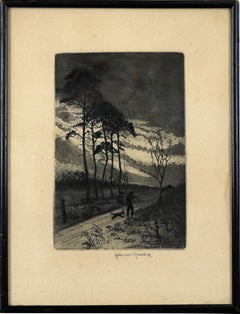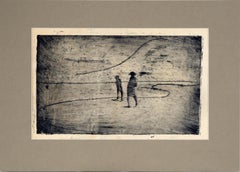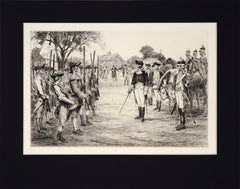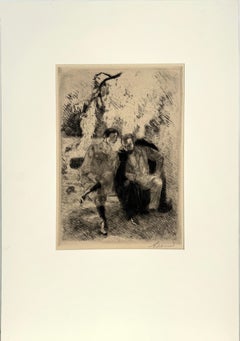Want more images or videos?
Request additional images or videos from the seller
1 of 12
Ralph Ludwig BoyerWashington Assumes Command - Hand Colored Engravingcirca 1930s
circa 1930s
$675List Price
About the Item
- Creator:Ralph Ludwig Boyer (1879 - 1952)
- Creation Year:circa 1930s
- Dimensions:Height: 17.75 in (45.09 cm)Width: 22.5 in (57.15 cm)Depth: 0.88 in (2.24 cm)
- Medium:
- Movement & Style:
- Period:
- Condition:
- Gallery Location:Soquel, CA
- Reference Number:Seller: 0022_DBH1stDibs: LU5425008451
About the Seller
5.0
Platinum Seller
Premium sellers with a 4.7+ rating and 24-hour response times
Established in 1986
1stDibs seller since 2014
3,062 sales on 1stDibs
Authenticity Guarantee
In the unlikely event there’s an issue with an item’s authenticity, contact us within 1 year for a full refund. DetailsMoney-Back Guarantee
If your item is not as described, is damaged in transit, or does not arrive, contact us within 7 days for a full refund. Details24-Hour Cancellation
You have a 24-hour grace period in which to reconsider your purchase, with no questions asked.Vetted Professional Sellers
Our world-class sellers must adhere to strict standards for service and quality, maintaining the integrity of our listings.Price-Match Guarantee
If you find that a seller listed the same item for a lower price elsewhere, we’ll match it.Trusted Global Delivery
Our best-in-class carrier network provides specialized shipping options worldwide, including custom delivery.You May Also Like
Winter Tracery (Milford Connecticut)
Located in San Francisco, CA
This artwork titled 'Winter Tracery (Milford Connecticut)" is an original drypoint etching by noted American artist Philip Kappel, 1901-1981. It is hand signed and titled in pencil by the artist. The plate mark (Image) size is 9 x 12 inches, framed size is 17.25 x 21.25 inches. Custom framed in a wooden light grey frame, with light grey matting and black color fillet. It is in excellent condition.
About the artist:
Philip Kappel — painter, illustrator, printer, writer, and lecturer — was born on February 10, 1901 in Hartford, CT and died in 1981. Kappel is best remembered for his landscapes, portraits, figures, marine, lithography, and etching. He held a teaching position with H. B. Snell, Boothbay, ME Studios, 1923 and 1924. His addresses in 1929 were 500 Fifth Avenue in New York City and, for the summer, care of Philip Little, 10 Chestnut Street, Salem, MA; and in 1935, Sarasota, FL.
Kappel was a pupil of the Pratt Institute Art School in Brooklyn, NY and Philip Little (1857-1942) and held memberships with the North Shore Artists Association in Gloucester, MA; the Marblehead...
Category
Mid-20th Century American Realist Figurative Prints
Materials
Drypoint, Etching
Villefranche-sur-mer
By Louis Conrad Rosenberg
Located in Middletown, NY
Etching with drypoint in brownish black ink on cream wove paper, 6 1/8 x 10 inches (155 x 255 mm), full margins with a deckle edge. Signed in pencil, lower right margin, and titled (...
Category
Early 20th Century American Realist Landscape Prints
Materials
Drypoint, Etching
Great cordiality - Figurative Drypoint Print, Colorful, Polish Art
By Czeslaw Tumielewicz
Located in Warsaw, PL
The print comes from edition limited to 10.
CZESLAW TUMIELEWICZ (b. 1942)
In 1968, he studied at the Architecture faculty of Gdank, before continuing his course at the Technical Uni...
Category
2010s Contemporary Figurative Prints
Materials
Paper, Watercolor, Drypoint
$478
H 7.88 in W 10.83 in
Don Quixote and apparition - Figurative Drypoint Print, Colorful, Polish Art
By Czeslaw Tumielewicz
Located in Warsaw, PL
Subject for this artwork comes from Miguel de Cervantes' book.
CZESLAW TUMIELEWICZ (b. 1942)
In 1968, he studied at the Architecture faculty of Gdank, before continuing his course a...
Category
Early 2000s Contemporary Landscape Prints
Materials
Paper, Watercolor, Drypoint
Flight over the manor house - Figurative Drypoint Print, Colorful, Polish Art
By Czeslaw Tumielewicz
Located in Warsaw, PL
Colorful figurative drypoint print by Polish artist Czeslaw Tumielewicz. The print is signed, it comes from edition limited to 10.
CZESLAW TUMIELEWICZ (b. 1942)
In 1968, he studied ...
Category
2010s Contemporary Landscape Prints
Materials
Paper, Drypoint, Watercolor
$334 Sale Price
20% Off
H 11.03 in W 8.27 in
Dulcinea and Don Quixote - Figurative Drypoint Print, Colorful, Polish Art
By Czeslaw Tumielewicz
Located in Warsaw, PL
Colorful figurative drypoint print by Polish artist Czeslaw Tumielewicz. Subject for this artwork comes from Miguel de Cervantes' book. The print is signed, it comes from edition lim...
Category
2010s Contemporary Landscape Prints
Materials
Paper, Drypoint, Watercolor
$334 Sale Price
20% Off
H 8.27 in W 11.03 in
Dulcinea - Figurative Drypoint Print, Colorful, Polish Art
By Czeslaw Tumielewicz
Located in Warsaw, PL
Subject for this artwork comes from Miguel de Cervantes' book. The print comes from edition limited to 5.
CZESLAW TUMIELEWICZ (b. 1942)
In 1968, he studied at the Architecture facul...
Category
2010s Contemporary Landscape Prints
Materials
Paper, Drypoint, Watercolor
$478
H 8.27 in W 11.03 in
Painter painting Don Quixote - Figurative Drypoint Print, Colorful, Polish Art
By Czeslaw Tumielewicz
Located in Warsaw, PL
Colorful figurative drypoint print by Polish artist Czeslaw Tumielewicz. Subject for this artwork comes from Miguel de Cervantes' book. The print is signed, it comes from edition lim...
Category
Early 2000s Contemporary Landscape Prints
Materials
Paper, Drypoint, Watercolor
$334 Sale Price
20% Off
H 8.27 in W 11.03 in
'Coupe Gordon Bennett 1909' original lithograph by Marguerite "Gamy" Montaut
By Marguerite Montaut
Located in Milwaukee, WI
"Coupe Gordon Bennett 1909 — Curtiss le Gagnant" is an original Lithograph with Pochoir created by Marguerite Montaut (GAMY). Gamy presents the viewer w...
Category
Early 1900s American Realist Landscape Prints
Materials
Lithograph, Ink
Marguerite Montaut'Coupe Gordon Bennett 1909' original lithograph by Marguerite "Gamy" Montaut, 1909
$6,500
H 26.63 in W 41.38 in
"French Air Show with Remarque of Head of Pilot, " Lithograph & Stencil by GAMY
By Marguerite Montaut
Located in Milwaukee, WI
"French Air Show with Remarque of Head of Pilot" is an original lithograph and stencil print by Marguerite Montaut (GAMY). It depicts an early airplane flying above a crowd of specta...
Category
1910s American Realist Landscape Prints
Materials
Lithograph, Stencil, Ink
$5,750
H 26.25 in W 41.625 in
More From This Seller
View All"End of Day" Original Limited Edition Etching
Located in Soquel, CA
"End of Day" Original Limited Edition Etching by John McGrath (Irish/American b.1884 d.1942).
This etching depicts a man with a tool slung over his shoulder walking along a path th...
Category
Early 20th Century American Realist Landscape Prints
Materials
Paper, Ink, Drypoint, Etching
Two Figures on the Shore - Minimalist Landscape Drypoint Etching in Ink on Paper
By Doris Warner
Located in Soquel, CA
Two Figures on the Shore - Minimalist Landscape Drypoint Etching in Ink on Paper
Minimalist landscape with two figures walking along the shore by Doris Ann Warner (American, 1925-201...
Category
1980s Minimalist Landscape Prints
Materials
Paper, Ink, Drypoint
$460 Sale Price
20% Off
Washington Assumes Command - Etching on Paper
Located in Soquel, CA
Washington Assumes Command - Etching in Ink on Paper
Historical engraving by Ralph Ludwig Boyer (American, 1879-1952). George Washington is shown holding a sword, with an army stand...
Category
1930s Impressionist Figurative Prints
Materials
Paper, Drypoint, Lithograph
"Confidences" James Abbott McNeill Whistler Conversation with a Fellow Artist
By Paul Albert BESNARD
Located in Soquel, CA
"Confidences" James Abbott McNeill Whistler Conversation with a Fellow Artist
"Confidences" James Abbott McNeill Whistler Conversation with a Fellow Artist
A Drypoint etching on Wove...
Category
Early 1900s Impressionist Figurative Prints
Materials
Handmade Paper, Drypoint, Etching
The British Evacuate Boston - 1932 Etching on Paper
Located in Soquel, CA
The British Evacuate Boston - 1932 Etching on Paper by Allen Lewis. From the portfolio "The Bicentennial Pageant of George Washington."
In this piece George Washington is front and ...
Category
1930s American Realist Figurative Prints
Materials
Laid Paper, Etching
Les Tuileries, Paris - Hand Colored Lithograph 1845-1860
Located in Soquel, CA
Les Tuileries, Paris - Hand Colored Lithograph
Delicate hand-colored lithograph of Tuileries Palace in Paris, France printed by Rose-Joseph Lemercier (French, 1803 - 1887). Published, Paris 1843 to 1867 by Hautecoeur Freres (Eugène and Alfred Hautecoeur (French). After Charles Riviere...
Category
Mid-19th Century Romantic Landscape Prints
Materials
Paper, Ink, Watercolor
Still Thinking About These?
All Recently ViewedMore Ways To Browse
Hockney Los Angeles Olympics
Hogarth Election
House Of Raquel Vega
Inuit Doll
Iona Rozeal Brown
Iris Woodblock Print
Irving Amen On Sale
Israel Museum Poster
Itzchak Tarkay Afternoon Tea
Itzchak Tarkay Serigraph
Ivory Cigarette Holder
J Alphege Brewer
J Didier
Jack Chandler
James A Pritchard
Jane Rogers
Japanese Warrior Woodblock Print
Japanese Woodblock Print Kuniyoshi



